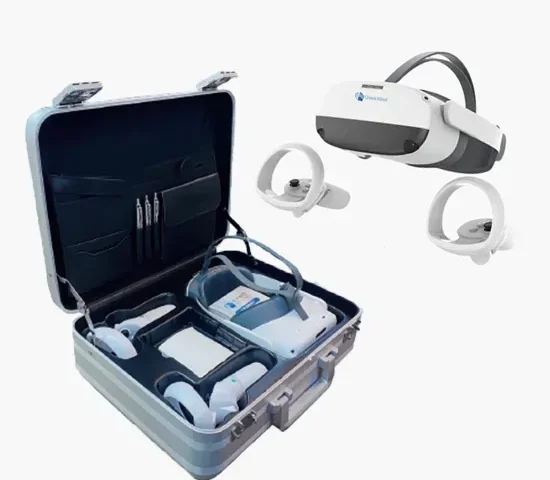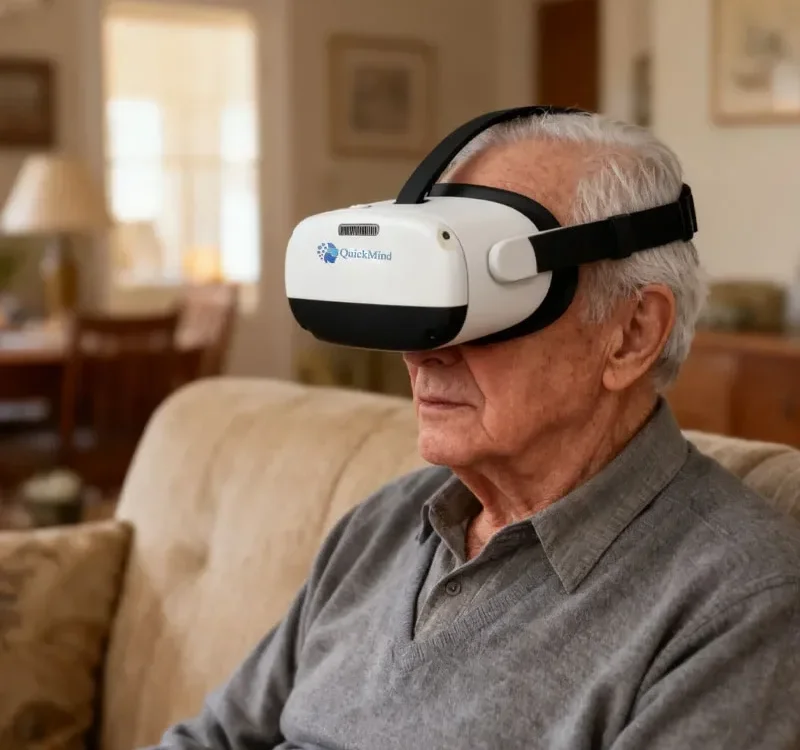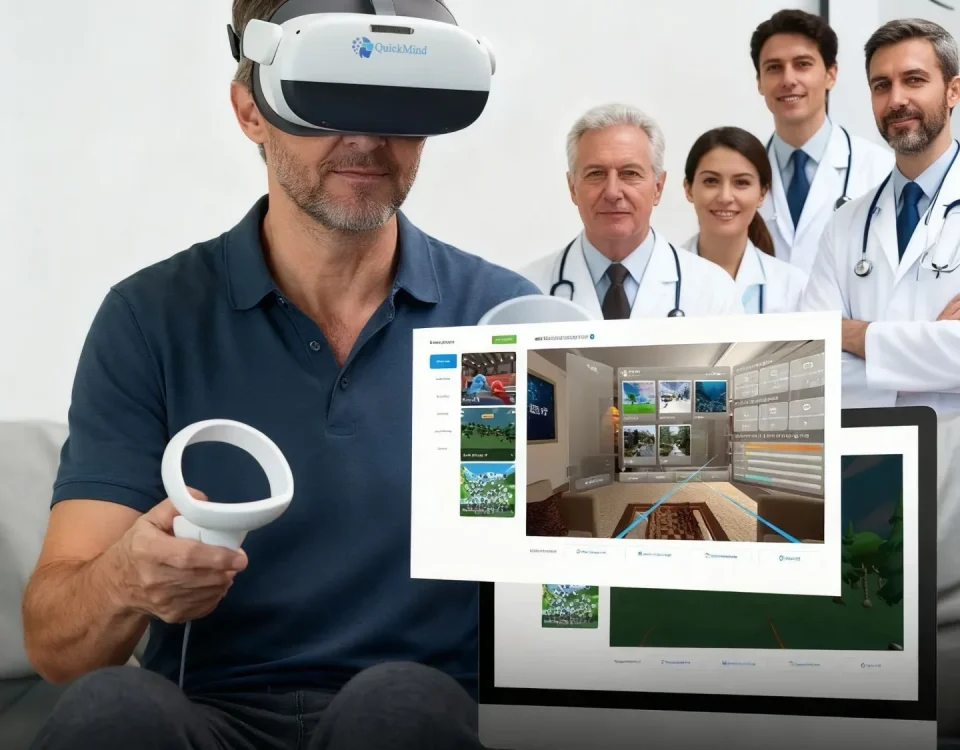
Unlocking the Power of Your Cognitive Function
2024-12-17
Why VR Rehab Is Transforming Home Care for Seniors
2025-10-06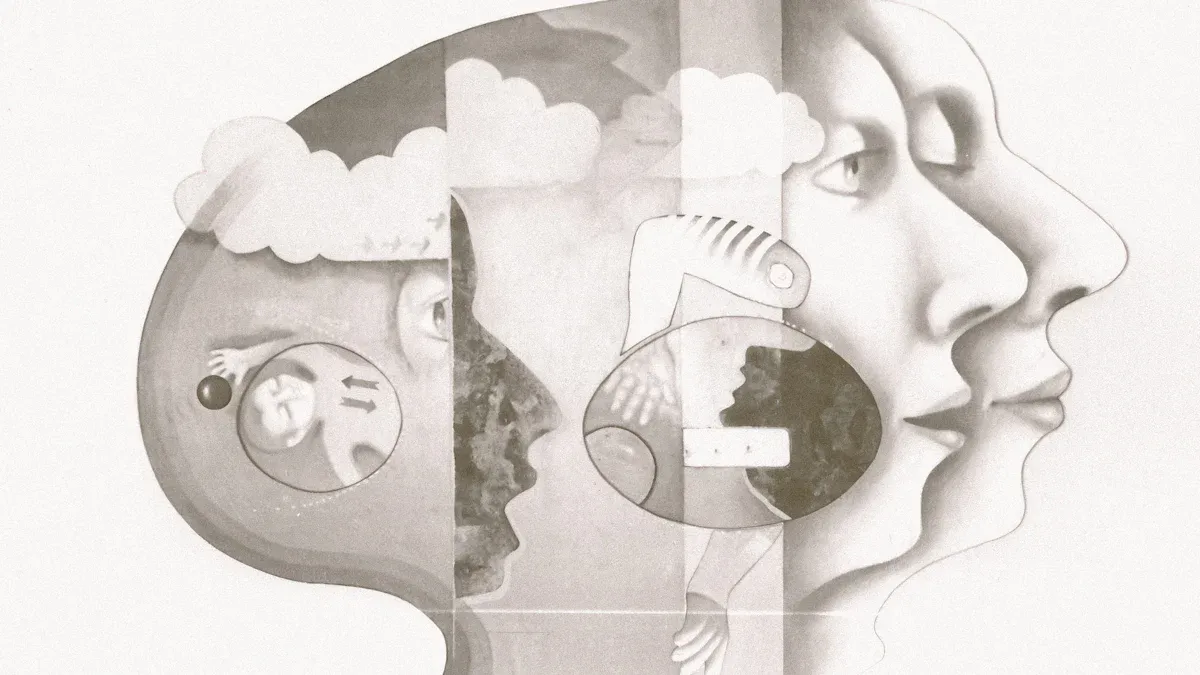
Imagine you face a choice between traditional cognitive rehab and a new technology-driven approach. You want a solution that matches your unique needs and goals. QuickMind gives you a personalized recovery experience, using advanced tools like AI and VR. In recent years, more people have chosen digital platforms for cognitive rehab because these options adapt quickly and keep you engaged. You benefit from treatment that fits your progress and motivates you to participate.
Key Takeaways
- QuickMind offers a personalized cognitive rehab experience using AI and VR technology, adapting to your unique needs.
- The system provides real-time adjustments to your rehabilitation plan, ensuring tasks match your current abilities and progress.
- Eye-tracking technology in QuickMind helps assess cognitive functions and tailor exercises to target specific deficits.
- Traditional cognitive rehab methods rely on therapist-led sessions and structured exercises, providing personalized support but less adaptability.
- Group therapy in traditional methods fosters social interaction and peer support, enhancing motivation and reducing feelings of isolation.
- QuickMind allows for remote access, making it easier to continue rehabilitation from home, especially for those with mobility issues.
- Combining QuickMind with traditional therapy can create a balanced approach, leveraging technology while maintaining human support.
- Choosing the right rehab method depends on your personal preferences, comfort with technology, and specific cognitive needs.
QuickMind
Overview
You want a cognitive rehabilitation solution that adapts to your needs and delivers results. QuickMind offers a modern approach to cognitive assessment and rehab. The QuickMind VR Assessment & Rehab (Enterprise) system uses virtual reality and artificial intelligence to create a personalized experience for you. You complete a rapid cognitive assessment in just five minutes. The system then generates a tailored rehabilitation plan based on your results. You receive a program that matches your abilities and goals.
Features
VR and AI
QuickMind uses advanced VR technology to immerse you in realistic rehab scenarios. You interact with environments that challenge your attention, memory, calculation, and executive function. Artificial intelligence analyzes your performance and adjusts the difficulty level in real time. You stay engaged and motivated because each session feels fresh and relevant to your progress. The system provides multimodal stimulation, including visual, auditory, and tactile feedback. This multisensory approach helps your brain adapt and reorganize, supporting neuroplasticity and recovery.
Eye-Tracking
The QuickMind system includes eye-tracking technology. It monitors your eye movements to assess cognitive functions such as reaction time and abstract reasoning. You receive feedback on your performance, and therapists can use this data to customize your rehabilitation plan. Eye-tracking allows for a deeper understanding of your strengths and areas for improvement. You benefit from a program that targets your specific cognitive deficits.
Brain Health System
QuickMind features a comprehensive Brain Health Management System. You can manage your health records, training plans, and progress through an integrated online platform. The system tracks your rehabilitation effectiveness in real time. You and your healthcare provider can review your results and update your plan as needed. This scientific approach ensures that your recovery stays on track and adapts to your changing needs.
Users
QuickMind serves a wide range of users. Healthcare providers use the system to enhance cognitive assessment and rehabilitation for patients. Individuals seeking effective rehab solutions benefit from personalized care and continuous progress tracking. The Enterprise version includes a VR headset and options for eye-tracking assessment or customized training. Priced at $2,999, QuickMind delivers advanced features for both clinical and personal use. You experience immersive, adaptive, and engaging rehab scenarios designed for optimal recovery.
Discover how QuickMind® can transform your cognitive rehabilitation journey! Check it out here.
Traditional Methods

Overview
You may find traditional cognitive rehabilitation methods in many clinical settings. These approaches have helped people recover cognitive abilities for decades. Therapists use structured exercises and strategies to restore or compensate for lost functions. You often work with a professional who guides you through each step. The goal is to improve your memory, attention, and problem-solving skills so you can manage daily life more independently.
Techniques
Therapist-Led
You work directly with a trained therapist. The therapist observes your strengths and weaknesses, then creates a plan tailored to your needs. Sessions may include memory drills, attention exercises, and problem-solving tasks. The therapist provides feedback and encouragement, helping you stay motivated. You benefit from expert guidance and a supportive environment.
Paper Tasks
You complete exercises using paper and pencil. These tasks might include word lists, puzzles, or visual imagery activities. Paper-based methods help you practice skills like calculation, reasoning, and recall. You can track your progress over time and see improvements in specific areas. Many clinics use these exercises because they are easy to administer and customize.
Group Sessions
You participate in group therapy with others facing similar challenges. Group sessions encourage social interaction and peer support. You share experiences, learn new strategies, and practice cognitive skills together. The group setting helps you build confidence and motivation. You also benefit from seeing how others overcome obstacles.
Tip: Group sessions can boost your mood and reduce feelings of isolation. You gain encouragement from others and develop new friendships.
Common Techniques in Traditional Cognitive Rehab
- Restorative approaches focus on repeated exercises to rebuild cognitive functions.
- Compensatory strategies help you use remaining abilities and external aids.
- Spaced retrieval and errorless learning improve learning rates, especially for dementia patients.
| Technique Type | Description |
|---|---|
| Restorative Approaches | Techniques like word lists, visual imagery, and mnemonic strategies aimed at restoring memory. |
| Compensatory Strategies | Use of external memory aids such as memory notebooks and assistive technology tools. |
| Errorless Learning | A method that helps in teaching specific information while minimizing errors in memory tasks. |
| Computer-Assisted Training | Utilizes technology to improve cognitive functions like attention and memory. |
Strengths
You experience several benefits with traditional cognitive rehab methods. Therapist-led, paper-based, and group therapy approaches enhance your quality of life. These methods build on your strengths and abilities, helping you set realistic goals for everyday functioning. You receive personalized support and guidance, which improves learning, memory, and executive functioning. Group sessions promote social contact and peer support, making recovery less isolating. You also relearn skills needed for daily life, supporting your independence. Many people combine traditional methods with new technologies like QuickMind to maximize their recovery.
Limitations
When you use traditional cognitive rehabilitation methods, you may encounter several limitations that can affect your recovery journey. While these approaches have helped many people, they do not always meet every individual’s needs or circumstances.
One of the main challenges you might face is the difficulty in personalizing your rehabilitation plan. Therapists often rely on standardized exercises and manual adjustments. This process can make it hard to tailor each session to your unique strengths and weaknesses. You may find that the tasks do not always match your current abilities or progress, which can slow down your improvement.
Another limitation involves monitoring your engagement and progress. In traditional settings, therapists observe your performance during sessions, but they may not capture subtle changes or fluctuations in your cognitive abilities. If you miss appointments or have inconsistent attendance, your therapist may struggle to track your progress accurately. This gap can lead to less effective interventions and missed opportunities for timely adjustments.
Access to in-person rehabilitation can also present significant barriers. If you live far from a clinic or have mobility issues, attending regular sessions becomes difficult. Physical impairments, transportation challenges, and geographical distance can prevent you from receiving consistent care. As a result, you may experience suboptimal adherence to your rehabilitation plan.
You may also face challenges related to technology and digital literacy, especially if you are an older adult. Many traditional programs now incorporate some digital tools or telerehabilitation options. However, you might struggle to operate these devices independently. Sensory impairments, such as hearing or vision loss, can further complicate communication and participation in these programs.
Note: Communication difficulties, especially those related to hearing and vision, can make it harder for you to benefit fully from traditional or technology-assisted rehab methods.
Here are some common limitations you might experience with traditional cognitive rehab:
- Limited ability to adjust tasks to your individual needs in real time.
- Challenges in monitoring your engagement and progress outside of scheduled sessions.
- Barriers to access due to physical impairments, transportation issues, or living in remote areas.
- Difficulties using digital tools if you have reduced digital literacy or lack familiarity with technology.
- Communication problems caused by sensory impairments, such as hearing or vision loss.
You should consider these factors when choosing a rehabilitation approach. Understanding these limitations can help you and your healthcare provider select the best path for your cognitive recovery.
Personalization

QuickMind Approach
You experience a new level of personalization with QuickMind. The system uses artificial intelligence and eye-tracking technology to assess your cognitive abilities. You complete a screening that matches the accuracy of established tools. The system analyzes your performance in areas like attention, memory, and executive function. You receive a detailed report that highlights your strengths and areas for improvement.
- AI reviews your results and creates a rehabilitation plan tailored to your needs.
- Eye-tracking monitors your reactions and helps the system adjust tasks in real time.
- You train in immersive virtual reality environments that match your abilities and interests.
- The program updates as you progress, keeping each session challenging and relevant.
You benefit from a rehab experience that adapts to your unique profile. The system ensures that your training plan fits your goals and changes as you improve.
Tip: Personalized plans help you stay motivated and achieve better outcomes. You see your progress and know that each session targets your specific needs.
Traditional Approach
You also find personalization in traditional cognitive rehabilitation. Therapists set goals that match your individual needs. You start with a neuropsychological assessment that identifies your strengths and weaknesses. Your therapist creates a program using proven techniques that fit your abilities.
- Therapists monitor your progress and adjust interventions as needed.
- You receive exercises that match your current skill level.
- Regular reviews ensure that therapy remains effective and challenging.
- The approach promotes independence and functional recovery.
You work closely with your therapist to update your plan. The process relies on expert observation and manual adjustments to keep your rehab on track.
Note: Personalized therapy helps you regain skills for daily life. You receive support that matches your pace and abilities.
Comparison
You notice key differences in how each approach personalizes your rehabilitation. QuickMind uses technology to analyze your data and adjust your plan instantly. You receive feedback during each session, and the system updates your training based on your performance. You experience immersive scenarios that keep you engaged and motivated.
Traditional methods rely on therapist expertise and manual adjustments. You benefit from human interaction and support, but changes to your plan may take longer. Therapists review your progress and update your exercises during scheduled sessions.
| Personalization Feature | QuickMind | Traditional Methods |
|---|---|---|
| Assessment | AI and eye-tracking | Neuropsychological evaluation |
| Plan Adjustment | Real-time, data-driven | Manual, therapist-led |
| Session Experience | Immersive VR, adaptive difficulty | Paper tasks, group or solo therapy |
| Progress Tracking | Automated, continuous | Therapist observation |
| Motivation | Dynamic, engaging scenarios | Supportive, social environment |
You choose the approach that fits your needs and preferences. QuickMind offers rapid, data-driven personalization. Traditional methods provide expert guidance and human connection. Both paths help you achieve your recovery goals.
Adaptability
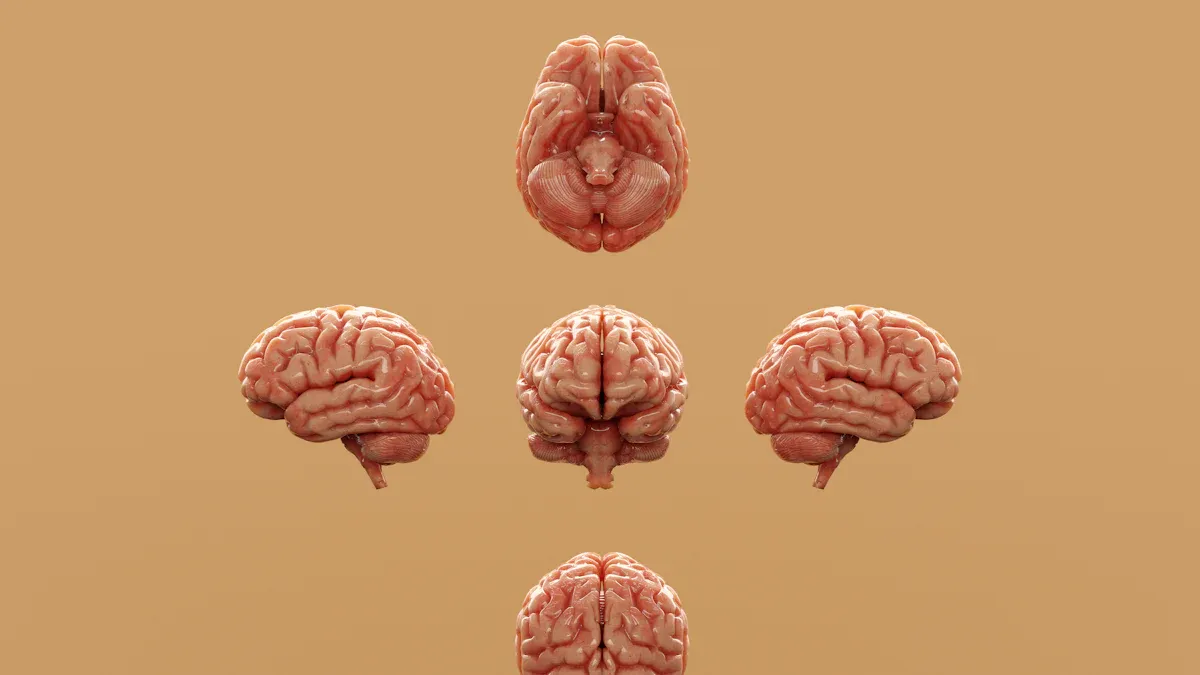
QuickMind Flexibility
You want a rehabilitation system that responds to your progress and changing needs. QuickMind gives you dynamic adjustment during every session. The system uses artificial intelligence to analyze your performance and adapts the difficulty level instantly. You never get stuck with tasks that are too easy or too hard. The program updates your rehabilitation plan as you improve, keeping you challenged and engaged.
Remote access is another advantage. You can use QuickMind from home or in a clinic. This flexibility helps you continue your recovery even if you cannot travel. The integrated Brain Health Management System tracks your progress in real time. You and your healthcare provider can review your results and make changes to your plan whenever needed. You stay motivated because you see your improvements and know your training matches your abilities.
Tip: Continuous progress tracking helps you and your provider adjust your goals and strategies quickly, making your recovery more effective.
Traditional Flexibility
Traditional cognitive rehab methods offer some adaptability, but you may notice limits. Therapists adjust your plan based on their observations and your feedback. You receive exercises that match your current skills, and your therapist updates your program during scheduled sessions. However, these changes often happen less frequently than with digital systems.
You might find that traditional methods do not always respond quickly to your progress. Therapists rely on standardized exercises and manual adjustments. This process can make it hard to personalize your sessions in real time. Advancements in smart prompting technologies aim to address these limitations, but traditional approaches may not achieve the same level of flexibility.
- Traditional methods lack flexibility and adaptability to changing user needs.
- Machine learning prompting systems can adapt to individual needs and changing circumstances, which traditional methods may not achieve effectively.
- Individualized prompts that fit your context can reduce caregiver burden and improve outcomes.
| Factor Influencing Adaptability | Description |
|---|---|
| Patient Preferences | Your preferences for treatment can affect how well you stick to your rehab plan. |
| Socio-demographic Characteristics | Your lifestyle and background play a role in which rehab method works best for you. |
| Cognitive Reserve | If you have higher cognitive reserve, you may prefer traditional rehabilitation. |
| Attitudes Toward Technology | Your comfort with technology influences how you use cognitive tools. |
User Needs
You have unique needs that shape your recovery journey. If you want a system that adapts quickly and tracks your progress, QuickMind offers strong flexibility. You benefit from remote access, real-time updates, and continuous monitoring. If you prefer in-person support and human interaction, traditional methods may suit you better, though they may not adjust as rapidly.
Consider your preferences, lifestyle, and comfort with technology. You should choose a rehabilitation approach that fits your goals and adapts to your changing needs. Both methods have strengths, but understanding their adaptability helps you make the best decision for your recovery.
Outcomes
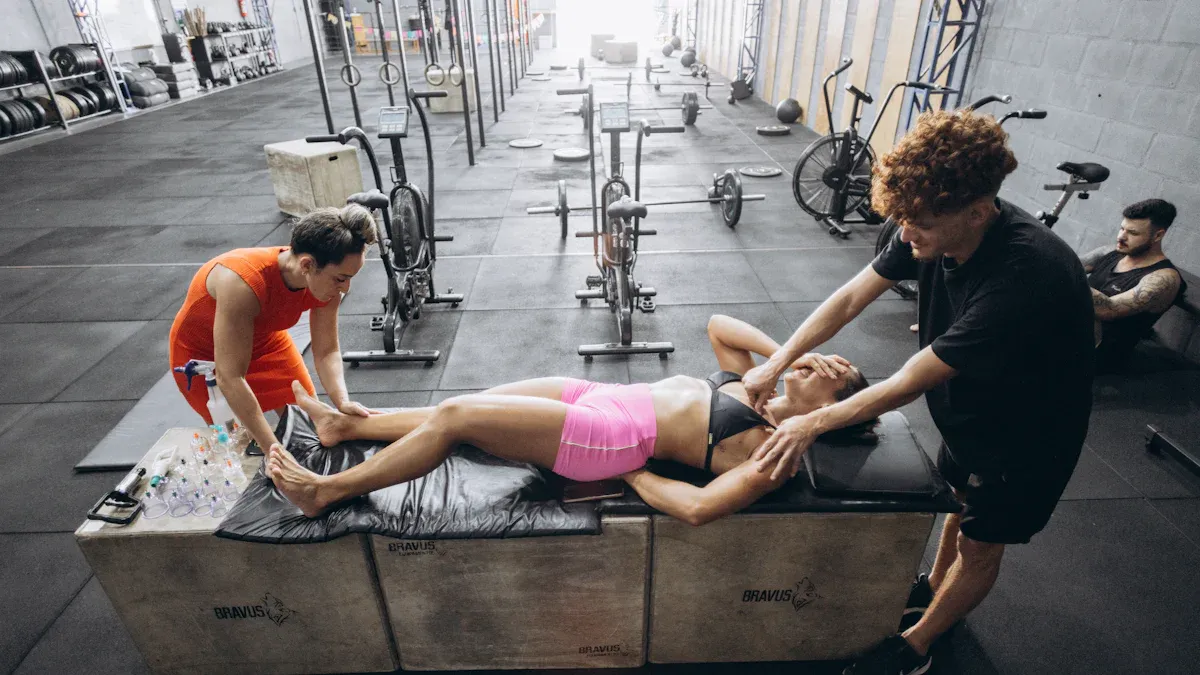
QuickMind Results
You see real-world improvements when you use QuickMind for cognitive rehabilitation. Many users report noticeable gains in focus, memory, and mental clarity. You may experience enhanced concentration and recall, which helps you perform better at work and in daily life. Increased energy levels often make tasks feel easier and less overwhelming.
- You may notice significant improvements in cognitive abilities, such as attention and executive function.
- Enhanced concentration and memory recall often become part of your daily routine.
- You might feel more energetic, which supports better performance in professional and personal tasks.
Testimonial:
Liem N. shares that QuickMind transformed his daily routine, making concentration easier and more effective. Mary R. describes how tasks that once felt overwhelming now seem achievable, with less mental fog. Fay Hosseini, a pharmacist, reports improved energy, focus, and memory recall after using the system.
Traditional Results
You can expect positive outcomes from traditional cognitive rehabilitation methods, especially when you work closely with a therapist. These approaches often improve your quality of life and help you regain independence. Clinical studies show that you may achieve better scores in daily functioning and occupational performance, especially within the first six months of therapy.
| Outcome Measure | Cognitive Rehabilitation Group | Control Group | WMD (95% CI) | p-value |
|---|---|---|---|---|
| DQoL (Quality of Life) | Improved | Not improved | 2.87 (0.79, 4.95) | 0.007 |
| NPI Severity (Neuropsychiatric) | No significant difference | No significant difference | -1.47 (-6.02, 3.08) | 0.53 |
| COPM (< 6 months) | Higher scores | Lower scores | 1.54 (0.16, 2.93) | 0.03 |
| COPM (> 6 months) | Similar scores | Similar scores | 1.50 (-0.31, 3.31) | 0.1 |
| Other Indicators | No significant differences | No significant differences | N/A | N/A |
You may see the greatest improvements in the first few months. Long-term results often depend on your engagement and the support you receive from therapists and peers.
Studies
You find that technology-based interventions, including VR and AI systems, show promising effects on cognitive function. These approaches often deliver moderate to large improvements across different cognitive domains. You benefit from transferable skills, but the effectiveness can vary depending on the specific intervention and how it is delivered.
| Approach | Effectiveness | Strengths/Weaknesses |
|---|---|---|
| Technology-based interventions | Promising effects on cognitive function with moderate to large effect sizes. | Transferable benefits across cognitive domains; effectiveness varies by intervention and delivery method. |
| Traditional interventions | No definitive conclusion on overall effectiveness compared to technology-based. | May provide greater participant satisfaction through personal support from therapists. |
Note:
You should consider several research limitations when comparing QuickMind and traditional methods. Many studies exclude older research, which may leave out relevant technologies. Most reviews focus only on computer-based software, ignoring devices like smartphones and tablets. Researchers often do not evaluate the effectiveness of programs or include cost-effectiveness data. Direct comparisons remain difficult because studies rarely describe technology features in detail. Many reports provide only basic descriptions, making it hard for you to judge which approach works best.
Pros and Cons

QuickMind Pros
You gain several advantages when you choose QuickMind for cognitive rehabilitation. The system uses VR technology to create immersive training environments. You interact with realistic scenarios that boost your engagement and motivation. Artificial intelligence personalizes your rehabilitation plan, matching exercises to your abilities and goals. The system adjusts training intensity and difficulty in real time, so you always face the right level of challenge.
You benefit from advanced data analysis. The AI reviews your performance and recommends optimal strategies for your recovery. Medical staff can manage devices and patient data efficiently through the backend management system. You also experience improved accessibility. VR technology offers new perspectives, helping you relax and reduce anxiety during training.
| Feature | Description |
|---|---|
| VR Technology | Provides immersive environments that simulate real-world scenarios. |
| AI Personalization | Matches rehabilitation plans and offers personalized recommendations. |
| Real-time Adjustment | Adjusts training intensity and difficulty based on your performance. |
| Data Analysis | Analyzes training data to determine the best rehabilitation strategy. |
| Backend Management | Enables efficient control of devices and patient data for medical staff. |
- AI gives you personalized recommendations for your training plan.
- The system adapts training intensity and difficulty instantly.
- VR environments help you and your caregivers experience relaxation and reduced anxiety.
Tip: QuickMind’s technology keeps you motivated and ensures your rehab plan fits your progress every step of the way.
QuickMind Cons
You may encounter some challenges when using QuickMind. The system relies on advanced technology, which means you need access to VR equipment and a compatible device. You might need support to set up and operate the system, especially if you are not familiar with digital tools. Some users may prefer more direct human interaction during rehabilitation. You should consider your comfort with technology and your access to equipment before choosing this approach.
Traditional Pros
You benefit from several strengths when you use traditional cognitive rehabilitation methods. These approaches follow a structured and systematic process, helping you achieve functional changes in your daily life. Therapists guide you through exercises and monitor your progress closely. Human interaction plays a key role, making therapy sessions engaging and relevant. You receive individualized practices that address your specific needs and help you process information more effectively.
| Evidence | Description |
|---|---|
| Structured and Systematic | You follow a clear process that supports functional improvement. |
| Human Interaction | You engage with therapists, making sessions more meaningful and motivating. |
| Individualized Practices | Therapists tailor exercises to your unique strengths and weaknesses. |
- You work with professionals who understand your goals.
- Sessions include real-life situations and social support.
- Therapists adjust your plan based on your feedback and progress.
Note: Traditional methods offer a personal touch and proven strategies that help you regain independence and confidence.
Traditional Cons
When you choose traditional cognitive rehabilitation, you may face several challenges that can affect your recovery experience. While these methods have helped many people, they do not always fit every situation or need. Understanding the drawbacks helps you make an informed decision about your care.
1. Limited Personalization
Traditional rehab often relies on standardized exercises and manual adjustments. Your therapist may not always have the tools to tailor each session to your exact needs. You might find that some activities feel too easy or too difficult. This lack of real-time adaptation can slow your progress.
2. Accessibility Barriers
You may struggle to access in-person therapy if you live far from a clinic or have mobility issues. Transportation problems, physical disabilities, or living in rural areas can make regular attendance difficult. If you miss sessions, your progress may stall.
3. Inconsistent Progress Tracking
Therapists usually monitor your improvement during scheduled appointments. They may not capture subtle changes in your abilities between sessions. If you forget to mention difficulties or improvements, your therapist might not adjust your plan promptly. This gap can lead to less effective interventions.
4. Resource and Time Constraints
Traditional rehab often requires significant time from both you and your therapist. Scheduling conflicts, limited appointment availability, and therapist workload can delay your sessions. You may have to wait weeks for an opening, which can disrupt your momentum.
5. Technology Limitations
Some traditional programs now include digital tools, but you might find these options limited. Paper-based tasks and face-to-face sessions do not always use the latest technology. You may miss out on the benefits of real-time data analysis or adaptive training.
6. Reduced Engagement
You may lose motivation if exercises feel repetitive or disconnected from your daily life. Group sessions can help, but not everyone enjoys working in a group. If you prefer interactive or gamified experiences, traditional methods may not keep you as engaged.
| Challenge | Impact on You |
|---|---|
| Limited Personalization | Slower progress, less targeted exercises |
| Accessibility Barriers | Missed sessions, inconsistent care |
| Progress Tracking | Delayed plan updates, missed improvements |
| Resource Constraints | Long wait times, disrupted therapy |
| Technology Limitations | Fewer adaptive tools, less engaging experiences |
| Reduced Engagement | Lower motivation, less enjoyable sessions |
Note:
You should weigh these challenges against your personal needs and preferences. If you value flexibility, rapid feedback, or remote access, you may want to explore newer solutions. Traditional methods offer proven strategies, but they may not always provide the adaptability or convenience you seek.
User Fit
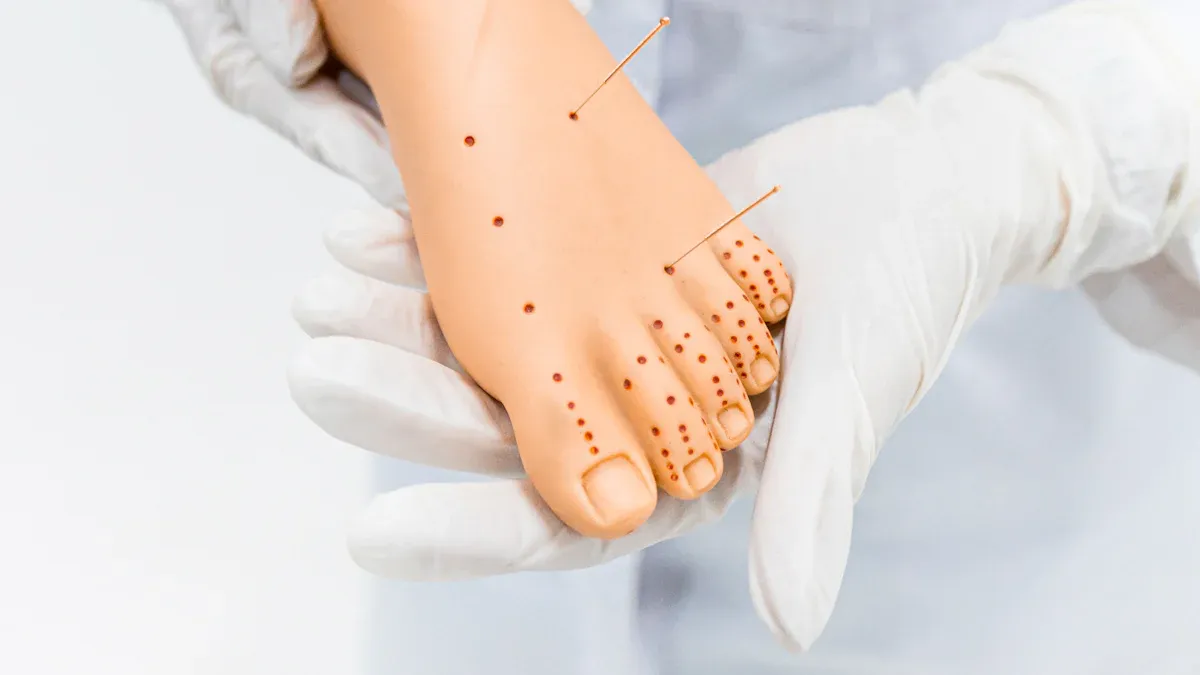
Factors
You want a cognitive rehabilitation approach that matches your unique situation. Several factors influence which method works best for you. Age plays a big role. Younger users often feel comfortable with technology and enjoy interactive tools. Older adults may prefer familiar routines and face-to-face support. Your comfort with digital devices also matters. If you use smartphones, tablets, or computers daily, you may adapt quickly to new systems.
The type and severity of your cognitive impairment shape your needs. Some users need intensive, personalized training. Others benefit from group support or structured routines. Your personal preferences guide your choice. You may value privacy, flexibility, or social interaction. Your daily schedule, transportation options, and access to clinics also affect your decision.
Tip: List your goals and challenges before choosing a rehab method. This helps you and your provider find the best fit.
| Factor | Why It Matters |
|---|---|
| Age | Influences tech comfort and learning style |
| Tech Comfort | Affects ease of using digital rehab tools |
| Impairment Type | Determines level of support and customization |
| Preferences | Guides choice between privacy or social support |
| Accessibility | Impacts ability to attend in-person sessions |
When QuickMind Excels
You see the best results with QuickMind if you want a highly personalized and adaptive experience. This system suits you if you enjoy technology and want real-time feedback. You benefit from immersive VR scenarios that keep you engaged and motivated. If you need flexible scheduling or remote access, this approach fits your lifestyle. QuickMind works well for users who want to track their progress and adjust their plan as they improve.
You may also prefer this system if you have busy days or live far from a clinic. The platform allows you to train at home and share results with your provider. If you like seeing data and want to understand your strengths, QuickMind gives you detailed reports and recommendations.
- You want rapid, data-driven adjustments.
- You enjoy interactive and gamified experiences.
- You need remote access or flexible scheduling.
- You value detailed progress tracking.
When Traditional Excels
You may find traditional methods work best if you value direct human interaction. These approaches suit you if you prefer working with a therapist in person. You benefit from structured routines and expert guidance. If you feel less comfortable with technology, traditional rehab offers familiar exercises and face-to-face support.
Group sessions help if you want social interaction and peer encouragement. You may also choose traditional methods if you have complex needs that require hands-on assessment. Some users prefer the accountability and motivation that come from regular appointments with a therapist.
- You want in-person support and guidance.
- You prefer paper-based or group activities.
- You need a structured routine.
- You value social interaction and peer support.
Combining Both
You may discover that combining QuickMind with traditional cognitive rehabilitation gives you the most complete recovery experience. This blended approach allows you to benefit from advanced technology while still receiving the personal support of a therapist. You can use QuickMind’s VR and AI-driven assessments to track your progress and adjust your training plan in real time. At the same time, you work with a therapist who guides you through exercises, offers encouragement, and helps you set practical goals.
Many users find that integrating digital tools with face-to-face therapy creates a balanced routine. You might start your week with immersive QuickMind sessions at home, then attend group therapy or individual appointments at a clinic. This schedule keeps you engaged and motivated. You receive instant feedback from QuickMind and thoughtful advice from your therapist. You build cognitive skills and also strengthen your emotional resilience.
Tip: Blending technology and traditional therapy helps you address both cognitive challenges and emotional well-being. You gain confidence as you see progress in your skills and your mindset.
A combined strategy works especially well if you face complex cognitive deficits or emotional barriers. For example, pairing QuickMind’s adaptive training with cognitive-behavioral therapy (CBT) creates a comprehensive plan. CBT teaches you coping strategies and helps you manage stress. QuickMind focuses on memory, attention, and executive function. Together, these methods help you regain independence and improve your quality of life within weeks or months.
| Benefit of Combining Approaches | How You Experience It |
|---|---|
| Real-time progress tracking | QuickMind monitors your skills instantly |
| Personalized feedback | Therapists adjust your plan and offer support |
| Emotional and cognitive growth | CBT builds coping skills and confidence |
| Flexible scheduling | You train at home and meet with therapists |
| Holistic recovery | You address both mind and mood |
You may choose a blended approach if you want the best of both worlds. QuickMind keeps your rehab plan adaptive and engaging. Traditional therapy provides human connection and expert guidance. You work toward your goals with a team that supports every part of your recovery. This combination helps you build lasting skills and a strong foundation for lifelong brain health.
QuickMind gives you a highly personalized path to cognitive recovery. Traditional methods still offer value, especially if you prefer in-person support. To choose the best approach, list your goals and talk with a healthcare professional. You might find that blending digital tools with therapist guidance works best.
Tip: Personalization and adaptability help you achieve better outcomes and stay motivated throughout your recovery journey.
FAQ

What makes QuickMind different from traditional cognitive rehab?
QuickMind uses VR, AI, and eye-tracking to create personalized rehab plans. You experience real-time adjustments and immersive scenarios. Traditional methods rely on therapist-led sessions and paper tasks, which may not adapt as quickly.
Can you use QuickMind at home?
Yes, you can use QuickMind remotely. The system allows you to complete assessments and training from home. You track your progress online and share results with your healthcare provider.
Is QuickMind suitable for older adults?
QuickMind suits users of all ages. If you feel comfortable with technology, you benefit from its adaptive features. You may prefer traditional methods if you want more face-to-face support.
How does QuickMind personalize your rehab plan?
QuickMind analyzes your assessment data using AI and eye-tracking. The system creates a plan that matches your abilities. You receive real-time updates as you improve, keeping each session relevant.
Can you combine QuickMind with traditional therapy?
You can blend QuickMind with traditional therapy. Many users train with QuickMind at home and attend therapist-led sessions for extra support. This approach helps you achieve better outcomes.
What equipment do you need for QuickMind?
You need a VR headset and a compatible device. The Enterprise version includes the necessary hardware. You access the Brain Health Management System online for progress tracking.
How quickly do you see results with QuickMind?
Many users notice improvements in focus, memory, and attention within weeks. You track your progress after each session. Results depend on your engagement and consistency.
Does insurance cover QuickMind or traditional rehab?
Coverage varies by provider and location. You should check with your insurance company. Some plans cover traditional therapy. QuickMind may qualify under certain health technology benefits.


